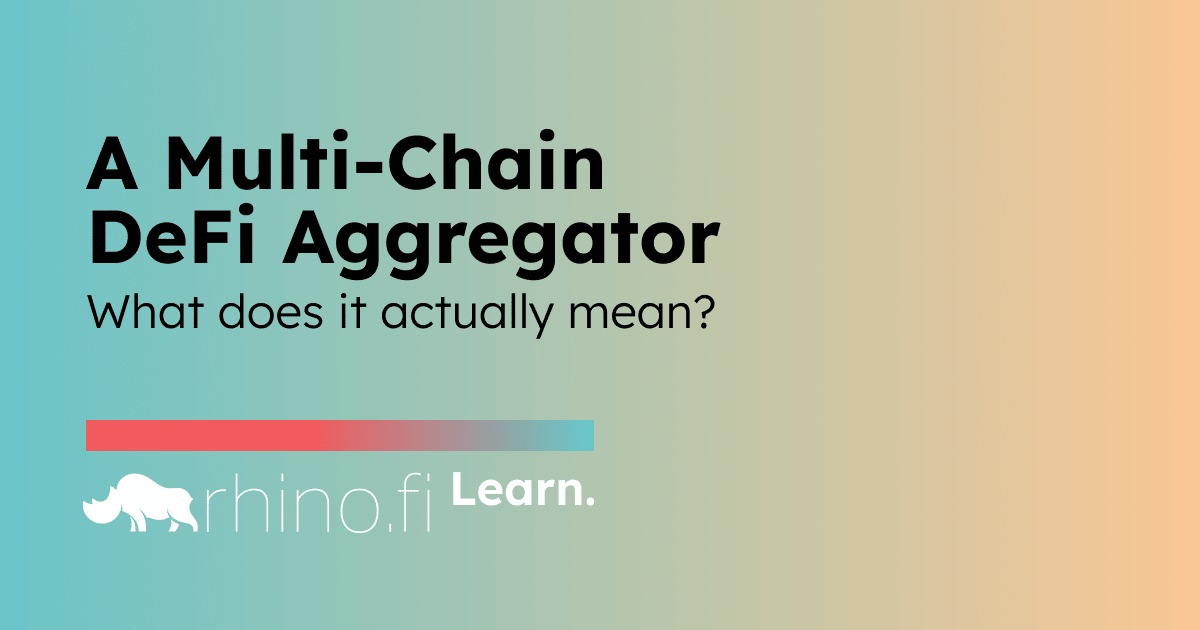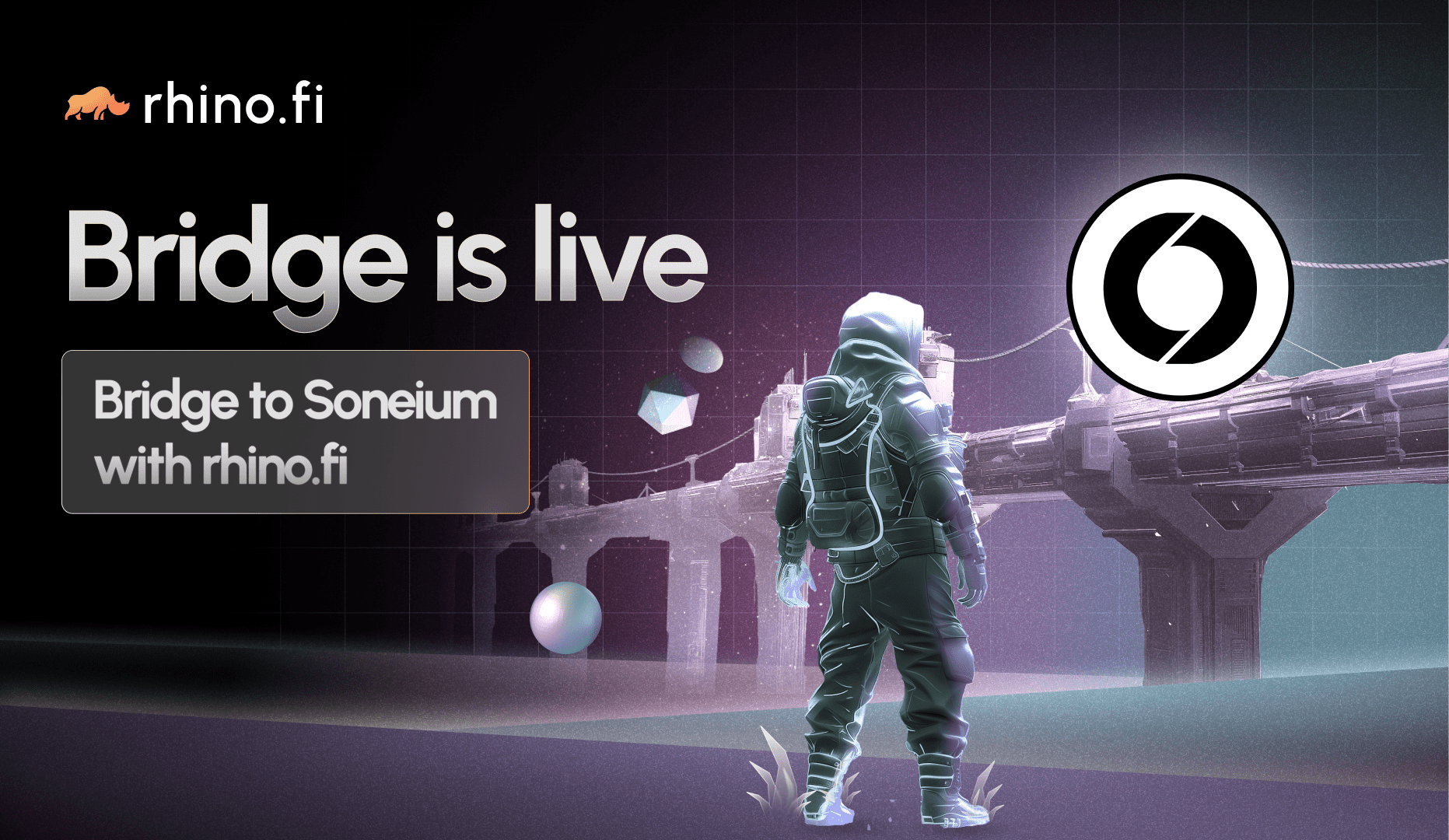Aggregation was one of the key trends of the web2 world we’ve just left. Apps like Netflix, Amazon and Spotify scoured the best opportunities from their particular sphere of interest and brought them straight to you, so you didn’t have to search yourself.
Multi-chain DeFi aggregators like rhino.fi take this concept and apply it to web3, specifically the world of decentralised finance, where tradeable assets have previously been siloed on individual blockchains with little connectivity.
An aggregator rounds up the best opportunities from different chains, either by collecting tokens from other exchanges and making them available instantly (in the case of swaps and trades), or providing a gateway to the protocol where the opportunity is held (in the case of yield opps).
The key thing here is that the aggregator displays all the opportunities in one interface, so you can move seamlessly between them and do everything from a single wallet.
Indeed, a good DeFi aggregator will actively seek to remove the pain-points that have blighted multi-chain transactions up till now, such as…
- Complex bridges
- Network switches
- Native gas tokens
- Multiple/Different wallet management
It will also provide an ultra-simple UX, which shows you the opportunities that are mooning right now, just like a ‘trending now’ or ‘recommended for you’ nav bar on a web 2 app.
In this post we’re going to drill right down into the topic and look at:
- Why we need DeFi aggregators
- How DeFi aggregators work for swaps and traders
- How aggregators work for yield
But if you’ve already read enough and want to see a DeFi aggregator in action, click below to enter our app.
Ok, so what’s the point of these DeFi aggregators?
In the old fiat world, the equivalent of a multi-chain DeFi aggregator would have been an app that allowed you to trade equities, bonds, commodities, Forex, real estate and all the other asset classes from a single platform.
Those apps did exist, but they were pretty rudimentary and the TradFi big-shots didn’t encourage you to use them.
Millions of people didn’t even have a bank account, let alone the means to pursue advanced trading, and even if you lived in a wealthier society, there was little financial education. If you wanted to put your money on the markets, you typically had to pay an expensive intermediary to do the work.
DeFi, as you’ll hopefully know by now, runs on entirely different principles. We believe that:
- Everyone should have access to every opportunity: in other words, everyone should be able to become a superstar trader if they want to.
- There should be no faceless middleman, or woman, taking their cut.
However, DeFi hasn’t really delivered on these principles up to now.
For one thing each chain is an island, with its own code and rules. The crossing-points have been extremely complex and often controlled by a centralised authority, which defeats the whole point.
For another thing, the world of blockchain is so fertile, so fast-moving, that it’s almost impossible to keep track of all the emerging projects. By the time you’ve found them, the moonshots have usually been snapped up.
What we need, then, is a single platform that brings you all the best opportunities with a super-simple UX, and abstracts away the painpoints of crossing between chains so you get total freedom of movement.
This is what rhino.fi, and a handful of other aggregators, are doing.
The core components of multi-chain DeFi aggregators
As tokenised versions of real-world assets become more commonplace in DeFi, we’re sure to see more and more aggregators adding them to their platforms.
At present, however, DeFi aggregators typically provide two main kinds of opportunity: active opportunities, like swaps and trades, and passive opportunities, notably yield opportunities.
Many DeFi aggregators will offer both types of opportunity, but here we’ll consider them separately, for the sake of simplicity.
Active: DeFi swap aggregators
Multi-chain swap aggregators strive to 1) allow you to swap assets from one chain to another and 2) ensure you get the best price on every single transaction.
This hasn’t been possible in the past. Frankly, trying to swap from one chain to the next has been as futile as trying to charge a Samsung phone with your Macbook cable.
However, swap aggregators have found several ingenious ways to get round this problem, using smart contracts. Here’s how rhino.fi does it:
- When a user requests a particular swap or trade, our engine runs all the token prices from different exchanges through its filters and picks out the best place to complete the transaction.
- The price is locked in and presented to the user.
- The user then signs the transaction to indicate that they want it to take place.
- This triggers a smart contract which executes the transaction automatically.
Each swap aggregator has their own means of doing this. The key point is that the aggregator brings tokens from all different chains together and makes them available, while retaining the core benefit of DeFi: self-custody based on rule of code.
What’s the more, the aggregator will, or should, find a way to simplify the multi-chain swap experience, so you can do it all in a couple of clicks. In our case, we’ve created liquidity outposts on different chains to remove the hassle of bridges (the post we wrote when we opened a gateway to BSC explains it well).
So you get the opportunity to trade tokens from loads of different chains in one place, which means less hassle and lower transaction fees. And, crucially, the aggregator does due diligence on all the tokens they list, so the scams and shit coins are smoked out before you see them.
Passive: DeFi yield aggregators
DeFi yield opportunities allow you to earn passive income by staking, lending or investing the tokens you don’t currently want to trade.
You usually receive a staked token in return for the amount you provide (a bit like a share certificate in fiat terms) and, unlike in the TradFi world, the staked version is ‘dynamic’, which means you can actively trade it without losing your income from the original asset.
PassInc options have grown sharply in popularity recently thanks to Ethereum’s adoption of proof-of-stake validation. Until recently, however, these opportunities were scattered across different protocols such as Curve, Balancer and Lido, held on a variety of different chains.
DeFi yield aggregators solve this problem by establishing a connection to these projects and allowing users to access them via the central gateway. Again, smart contracts hold the key, enabling participants to bridge their funds directly to the opportunity provider and receive the staked counterparts in return.
This means that:
- You can do everything on one platform. People often (but by no means always) pursue PassInc as part of a blended strategy so they can ride out volatility surges and adjust their weightings to market moves. With an aggregator you can run your passive and active strategies in tandem, which makes things much more fluid.
- You can see all the rates in one snapshot. A good aggregator will show the various opportunities side by side, so you can compare before you invest. This is something we’ve really worked hard on with our Explore page.
- You can quickly switch between opportunities. You can tell the aggregator to switch up your holding when something better comes along. This is something we’re incorporating (announcement coming soon).
- You save on fees. If the aggregator is hosted on layer 2, like rhino.fi, you will face minimal fees and entering or exiting your yield positions, so there is no penalty for opportunity.
And, again, the aggregator performs the due diligence before any opportunity is displayed. This is particularly important for yield projects: we’ve seen several providers promising unsustainably high yield and some have been little better than Ponzi schemes.
An aggregator can identify and filter out these scamsso you only see the genuine opportunities.
A quick note here though: when using DeFi aggregators or any other DeFi platform, users should do their due diligence and a listing on the platform is not a recommendation. At rhino.fi we do our best to curate the best opportunities, but there are still risks.
Ok, so that’s all you need to know for now
The technology and scope of DeFi aggregators is sure to keep advancing fast in years to come, and at rhino.fi we’re determined to lead the charge. We’ll be sure to keep you informed of each new innovation, so you never have to search for opportunity again.




